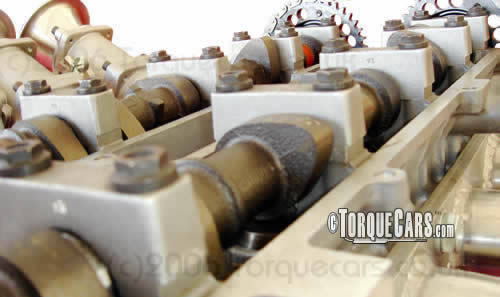Camshafts durations and profiles.
"Cam(alot) of power!"

Cam profiles and cam durations.
The cam shaft controls the inlet and outlet ports. A pear shaped lobe on the shaft keeps the valve closed until the pointy bit rotates producing lift and opening the valve. Double overhead cams have separate profiles for inlet and outlet ports and are more tunable than single overhead cams.
The timing of the opening and closing of the port can greatly affect engine characteristics. Manufacturers profile the cams to give good economy and reasonable performance through the low to mid rev range.
Some high performance cams come marked for competition use only. This is important as a competition car is stripped and rebuilt regularly and the competition cams can wear much more quickly than standard cams completely stuffing any lift benefits you were hoping to gain. Running a fingernail over the lobe will show if there is any wear particularly in the center where contact is made with the lifter - if there is any more than 1mm wear it is time to replace the cam.
Different engines have different timing needs and a manufacturer has to fudge things to take a Friday engine into account along with an engine that has done 70,000 miles so you can see there is already vast room for improvement.

Cams help create more power (HP) in the mid to high rev ranges and come in the following types. (Its worth noting than in most applications high range Torque is unchanged but low range torque can suffer. The degrees figure relates to the duration of the cam and a full 720° or 2 revolutions of the crank, would not open the valves at all! This implies that ignition timing must also be reset for cam durations of 260° and above. A longer duration means more time to suck air and fuel into the engine.)
Mild Road Cam 257° – 260° Gives low end improvements and used in unmodified engines suitable for all car types and gives a smooth tick over. Fuel economy may actually improve and power and responsiveness will be greater.
Fast Road cam 270° – 285° Good compromise for a road car the tick over is still fairly smooth and emissions are within legal limits. A good choice for a car used daily and for weekend track use and perfect for a hot hatch. This profile still gives reasonable fuel economy and a choppy tick over.
Competition cams 290°–320° The best performance profile for an engine which works continually over 3000 revs. The tick over is very lumpy and irregular and the car is lumpy to drive round town. Fuel economy is pathetic and it is unlikely that a car with this fitted will pass any kind of emissions test.
Developments – Rover devised the VVC cam where the cam rotates within a rotating holder and creates a marvellous tunable engine. The cam durations and lift can be adjusted to match the engine speed – higher revs can give a different lift and duration to a slower engine speed.
Originally devised for economy the VVC engine has become a tuners dream and in its 1.8 form the engine can be tuned to deliver up to 220 bhp (were not just talking cam modification here). Not surprising then that this engine is fitted to Lotus and MG's.
Hondas VTEC valve timing system is equally impressive and provides two stages of valve timing. A gear chooses the profile with rpm so effectively there are 2 cam profiles to each valve and a lifter kicks in at a set rpm, so it picks the faster cam profile at a predefined rev range.
From the drivers point of view, as the revs climb the second stage is reached giving explosive power and an aircraft style scream. You get two cars for your money – an economical round town supermarket cruiser and a track day screamer. The short cranks in Honda engines give a lot more rev range and redline at around 7000-8000 rpm a lot higher than engines of a similar size.
To find the best cam profile for you car why not join our friendly community of car tuners and car enthusiasts and benefit from car specific recommendations.
Please Check out my YouTube channel, we're regularly adding new content...
PLEASE HELP: I NEED YOUR DONATIONS TO COVER THE COSTS OF RUNNING THIS SITE AND KEEP IT RUNNING. I do not charge you to access this website and it saves most TorqueCars readers $100's each year - but we are NON PROFIT and not even covering our costs. To keep us running PLEASE Donate here
If you liked this page please share it with your friends, drop a link to it in your favourite forum or use the bookmarking options to save it to your social media profile.
Feedback - What do You Think?
Please use our forums if you wish to ask a tuning question, and please note we do not sell parts or services, we are just an online magazine.
Help us improve, leave a suggestion or tip
Please watch this video and subscribe to my YouTube channel.

 Click to accept YouTube Cookies & Play.
Click to accept YouTube Cookies & Play.